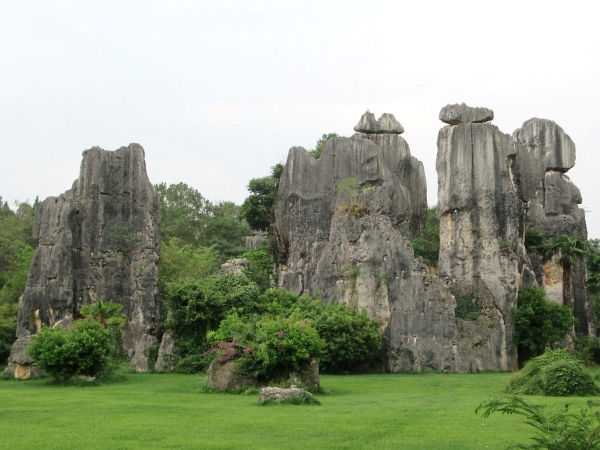The stone forest or Shilin, is a distinguished set of limestone formations spanning nearly 500 km2 located in Shilin Yi Autonomous County, Yunnan Province, China. The term “stone forest” comes from the way these structures seem to stretch forever, resembling a huge stone forest. Rain has consistently wiped away any soil, revealing the bleak face of this natural treasure. The provincial capital, Kunming, is 56 miles from stone forest.
The tall rocks give the impression of a stone forest because they appear to grow from the earth in a way that is akin to stalagmites. Many of the rocks resemble petrified trees. These incredible rocks formed by limestone weathering 270 million years ago. These tall, oddly shaped rock pillars are dispersed over an area of over 26,000 hectares. Merely 80 ha of this region are accessible to tourists.
The Kunming stone forest of Shilin are in good condition. Any traveler can benefit from bus service, which brings travelers from Kunming to these tourist destinations, which draw both domestic and foreign visitors. In the vicinity, there are many hotels to stay a night.
A beautiful girl of the Yi people named Ashima is said to have been born in Stone Forest. She was unable to wed her preferred suitor after falling in love, Ashima was swept away by a flood, so she turned into the stone that bears her name instead. This rock is located in the Lesser Stone Forest. She is regarded as the Sani people’s guardian. Yi people celebrate the Torch Festival, which includes folk dances and wrestling matches, on the 24th day of the sixth lunar month every year.
This basin collected substantial sandstone deposits that are covered with limestone throughout the Permian epoch of geologic time. The area elevated after depositing, and limestone pillars molded by wind and water. The Permian Makou Formation’s almost pure limestone is where the Major and Minor Stone Forests are found. The beauty of the sword-shaped limestone columns and the friendliness and customs of the Sani people draw visitors from all over the world to the Shilin Stone Forest, which the Chinese government first opened to the public in the 1950s.
The Permian Qixia Formation’s dolomite and limestone are the development of the Naigu Stone Forest, which is located 9 kilometers northeast of the Major Stone Forest. The ages of both formations are Lower Permian. They are composed of massive limestone and dolomite, bio-clastic limestone, calcarenite, calcilutite, and shallow water (platform) aggregates that add up to a thickness of 505 meters. Macroscopic fossil remains are rare to find in the Maokou Formation in Stone Forest, which appears to have undergone significant diagenetically changed conditions.
Under a microscope, biomicrite, biopelmicrite, and biopelmicrosparite limestones commonly contain single, whole, or fractured fusulinid foraminifera. The limestone has at least one zone where chert nodules are present. Dolomite in the Maokou Formation rarely varies above three percent, in contrast to the dolomitic Qixia Formation. The titles of the rocks are unforgettable: Mother and Son, Avalokitesvara Rock, Buddha Stone, Rhinoceros gazing at the moon, Ten Thousand Year Mushroom (10 m high), Camel Riding on Elephant, etc.
The strata form a moderate monocline that dips 2–6 degrees westward. During the pre-karst development stage, the primary channels for surface and subsurface water flowed through well-developed conjugate shear joints. The karst topography’s, orientation, size, and depth were determined by the cracks’ number, distribution, and orientation. The local groundwater is forced to flow from west to east by the sandstones and shales of the Liangshan Formation, which is located beneath the carbonate rock layers.
This formation acts as a permeability barrier. Moreover, there are five underground rivers, lakes, ponds, and waterfalls, as well as so many karst caves filled with stalactites, stalagmites, stone pillars, and stone corridors. The Stone Forest is divided into various picturesque sections with names like Greater Stone Forest, Lesser Stone Forest, Outer Stone Forest, Underground Stone Forest, Stone Forest Lake, and Da Dieshui Falls. It has a good environment and is adorned with over 400 different species of flowers.
The Greater and Lesser Stone Forests (also called the Lizijing Stone Forest), Naigu Stone Forest, Zhiyun Cave, Long Lake, Moon Lake, Qifeng Cave, and the Dadie Waterfalls are just a few of the picturesque locations found in the Stone Forest Scenic Region. Although the area is open all year round. However, the best time to visit Stone Forest is the rainy days, which are preferable because it is an outdoor location. It is advised that before leaving, you check the weather forecast. August/July is the peak month of the rainy season, which runs from May to October.
Read More: Pobiti Kamani: The Mysterious Stone Forest of Bulgaria



















